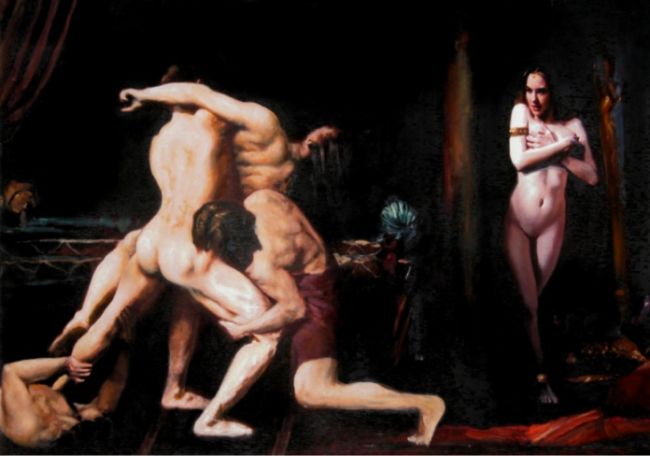William B. Miller, Jr. shares painting process

There has been a very interesting and rewarding progression in my painting technique over 40 years. As is typical, I began by learning to draw in life classes and painting from the live model. Over time, like most current artists, I began to use photographic resources to enhance those pictures. Landscapes were occasionally done plein air but were often done with a photographic visual reference. The problem using any single photograph is that the artist is accepting an inherently limiting boundary. During the last few years, even as I knew that I was becoming more technically adept, I felt as if my paintings were too safe, mundane and formulaic. I began to feel strongly that it was important for me to move beyond the decorous and static figures I had previously been doing and that my paintings would be more satisfying if they were infused with more vitality and had a dramatic sensibility. Initially, I felt that this could be achieved by simply utilizing a more direct gaze from the model or some element of elevated eroticism, mystery, or romanticism.
Most recently, I have begun a series that has been the most pleasurable of my painting career focusing on some of the classical dramatic themes like Salome or Samson and Delilah but infusing them with a modern spirit and character. Doing this requires a multi-step computer progression beginning with a strong conception of the exact dramatic spirit and theme, for example, Salome dancing for King Herod. From that initial visualization, I compose a carefully crafted visual narrative utilizing as many as 20 sources for each painting. Each of these sources is combined, rearranged, and fit together akin to blocking in a canvas. Each conception goes through extensive iterations, changing figure placement, furnishings, architectural elements, adjusting lighting and contrasts to achieve an image that simply works for me. This then gets put aside to let my eyes and perspective rest, and this will be further altered over the course of about a month. At that point, I am content with that image as the basis of an oil painting. What I am currently interested in achieving is an image which has a sense of stagecraft and theatricality. There needs to be a dramatic focus that will engage the imagination of the viewer. Most importantly, it must be an action image, and not a passive one. Usually, the drama is enhanced by strong lighting from a single source to enhance the thematic elements.
After this stage, the laborious process of transferring it to canvas is done, and the entire image is reappraised since sizing a small computer image up in scale introduces distortions which are not apparent on a small basic computer image. An absolutely solid drawing is essential. From that point on, multiple layers of oil paint beginning with intermediate tones first, darks second and lightest areas last with carefully executed and adjusted highlights. When the painting is finished, it gets put away for up to 4 months, and then reappraised . Multiple sessions of readjustment are usually necessary. If all goes well, it has been a great journey.
There are many wonderful figurative works being done currently with great technical panache. Many of these include figures in repose or in a static moment. My artistic aim is invest my canvases with emotion, drama, and movement representing a vivid updating of a classical tradition.
William B. Miller, Jr.
Nov 7, 2010
